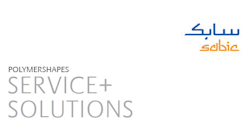At the American Public Transportation Association Expo 2017, SABIC showcased capabilities in additive manufacturing, glazing and carriage interiors that can help rail carriage engineers and interior designers and their suppliers expand engineering and design horizons while helping to reduce weight and maintenance, as well as capitalize on new production processes. The potential end benefits can make a significant difference to members of the rail industry’s value chain in terms of greater efficiencies in energy use and overall system costs.
Additive Manufacturing: Moving From Prototyping to Production
Additive manufacturing’s ability to accelerate the design and prototyping process, without the expense of tooling, is one of its key benefits, as is the potential for part consolidation and the development of commercial components.
SABIC has heightened its focus on advancing additive manufacturing from prototyping to full-scale production. In May, SABIC launched six filaments for fused deposition modeling and a new family of reinforced compounds for large format additive manufacturing to help customers capitalize on the potential of additive manufacturing as a production process.
As an example of the capabilities of additive manufacturing for rail, SABIC’s booth will feature a bracket created using ULTEM AM9085F filament, designed for use with Stratasys Fortus printers. The bracket, typically made from sheet metal, is used in rail carriage hidden spaces to mount ceiling components. ULTEM AM9085F filament is made from SABIC’s ULTEM resin, offering the same composition as the company’s injection molding grades. This polyetherimide (PEI) material is desirable for applications that require high heat resistance, high strength and low flame, smoke and toxicity.
“The bracket is one small example of the way SABIC is eager to partner with the rail industry to help customers make the leap from prototyping to full-scale additive manufacturing production,” said Lori Louthan, director, Mass Transportation, SABIC. “We’re enabling this evolution by creating a range of high-performance additive manufacturing materials — even industry-specific grades to meet regulatory requirements — and are supporting customers with our extensive expertise and resources for testing, design and application development.”
A Clear Choice for Side Window Components
Also on display is a passenger rail car side window component constructed by Total Plastics, Intl. from SABIC’s LEXAN FRA 25C sheet. The dual-pane side window consists of two .25 inch panes, CNC routed and assembled with a gasket spacer. LEXAN FRA 25C sheet is a coated, flame retardant polycarbonate sheet that passes ASTM E162 for flame spread; ASTM E662 for optical smoke density and ASTM E1354 for heat release. The sheet offers high impact resistance, with up to 70 times the impact resistance of laminated glass. The sheet has been developed for rail glazing applications.
Continued Material Innovation to Enhance Design Options
Railway coach manufacturers now have a new material to inspire a fresh approach to design and coach aesthetics while addressing key safety regulations, thanks to an innovative polycarbonate sheet solution from SABIC being introduced today. Visitors to SABIC’s booth can see new LEXAN DH65011 sheet’s versatility in a seat back shell manufactured by Khrome Product Transport.
LEXAN DH65011 sheet is a thermoformable opaque, solid, low-gloss polycarbonate/acrylonitrile-butadiene-styrene (PC/ABS) material that can be used for interior walls, ceiling components and for back and base shells of passenger seats. LEXAN DH65011 sheet is also compliant with the U.S. Federal Railroad Administration fire safety standard for passenger rail car interior walls, ceilings and seat frames, NFPA 130.
This new high-performance material solution is well-positioned to help railway interior designers and manufacturers create attractive components via the nearly unlimited decorative customization options that the new LEXAN DH65011 sheet provides. Overall fuel efficiency of mass transit systems can also be improved, as this lightweight material can help manufacturers to reduce the weight of railway interiors.
LEXAN DH65011 sheet offers customers a non-chlorinated and non-brominated material that supports their sustainability efforts and is available in custom colors and patterns.
Compared to polyvinyl chloride (PVC), thermosets, and sheet molding composite (SMC), the new LEXAN sheet material is significantly lighter in weight and can lead to decreases in system costs by enabling the consolidation of parts, streamlined production and the avoidance of secondary operations such as painting, coating, machining and polishing.
The LEXAN DH65011 sheet is also resistant to the repeated use of various anti-graffiti cleaning agents used today. The new product is a cost efficient choice to replace phenolic fiber-reinforced plastic (FRP) materials used in many interior train applications including interior wall panels, window frames, ceilings and other large interior parts.
LEXAN DH65011 sheet combins high impact strength with very high stiffness, while offering a low gloss surface finish after thermoforming. Its decorative capabilities can help avoid the cost and environmental hazards of secondary painting, and enables aesthetic choices to help customers in their quest to create a differentiated passenger experience.



